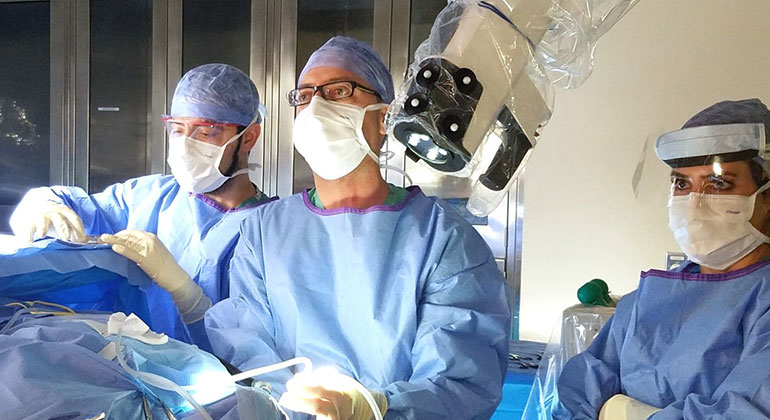
Otology-Neurotology Research at the Ear Institute
For more than two centuries, New York Eye and Ear Infirmary of Mount Sinai has transformed the way people live with hearing loss. As part of the oldest multispecialty hospital in the nation, our specialists have long been at the forefront of diagnosing hearing and balance conditions of the ear, evaluating the latest implantable and hearing-assisted devices, and exploring new surgical treatment options. Our physicians pave the way for advancements in the field—researching everything from common to rare and complex ear conditions.
In the ever-changing field of otology, technology evolves rapidly. We are recognized leaders in the field of implantable auditory devices including cochlear implants and bone anchored hearing aids. Our researchers collaborate with industry specialists and are intimately involved in evaluating new devices as they are being developed and tested. With access to the most cutting-edge diagnostic and surgical technology, including 7-Tesla imaging and intraoperative navigation, our otologists use new minimally invasive techniques, such as endoscope and exoscope to offer the most sophisticated options for patients. As one of the few hearing centers nationwide to specialize in vestibular disorders, the Ear Institute has also received several National Institutes of Health grants to investigate the relationship between hearing and balance.
Cochlear Implants
- New Candidates: In the past, cochlear implants were indicated mainly for patients with bilateral deafness. However, Mount Sinai otologists have helped change the landscape by exploring and expanding the types of people who would benefit from cochlear implants. We track outcomes in a variety of candidacy groups, including elderly patients, young children, individuals with single-sided deafness, and those who still have some residual hearing. While it was once thought that patients with cochlear implants would lose the remaining hearing in their implanted ear, our data shows that certain techniques can lead to preservation of hearing in both adults and children.
- Updated Models: Our surgeons have strong relationships with industry specialists and are front and center testing new devices as they are developed. We are currently in a multi-institutional trial comparing hearing preservation in a limited cochlear implant device versus the previous model. Our goal is to determine if they are both safe and effective, as well as what groups of patients would benefit most from the technology.
- Drug-eluting Implants: Researchers are investigating a type of cochlear implant that is coated with steroids and slowly releases medication into the inner ear. The goal is to evaluate the effect of this new therapy on hearing preservation rates and push the boundaries of candidates who may benefit from cochlear implants.
Bone Anchored Hearing Aids
- Subcutaneous Bone Anchored Hearing Aids: Consistently on the cusp of new technology as it becomes available, surgeons at Mount Sinai have been implanting two new cutting-edge bone anchored hearing aids: OSIA and Bonebridge. The new systems are only visible when they are being used, decrease the chance of soft tissue infection, and offer higher sound quality than the previous line of subcutaneous bone anchored hearing aids.
- Minimally Invasive Ponto Surgery (MIPS): This new technique was developed for implanting the Ponto bone anchored hearing aid. Researchers are investigating if MIPS reduces operating time and soft tissue complication rates.
Complex Ear Tumors
- Exoscope: Our surgeons were among the first in the world to use this robotically controlled digital microscope in neurotologic procedures. The exoscope improves visualization and offers increased mobility and flexibility while providing high-quality imaging in real time. In an effort to expand the use of the exoscope, our team at the Ear Institute will continue to evaluate the efficacy and safety of the exoscope in various neurotologic procedures and track standards and outcomes for patients.
- Endoscope: We perform the vast majority of procedures endoscopically, using the ear canal as an access point instead of an incision. Our research shows that patients who undergo endoscopic surgery recover faster, experience less pain, and have better overall outcomes. In an effort to expand its use, Mount Sinai surgeons are actively studying the endoscope in treating a variety of conditions including cholesteatoma and chronic ear infections, as well as some acoustic neuromas and glomus tumors.
Balance Disorders
- Hearing Loss and Imbalance: Falls are one of the most likely causes of morbidity in patients 65 years and older—an age when one in three adults also experience hearing loss. As part of an NIH grant, our experts are exploring the mechanisms by which hearing loss affects balance and falls.
- Virtual Reality: Balance disorders can be difficult to diagnose. As part of an NIH-sponsored study, our team is leading a groundbreaking clinical trial measuring the effectiveness of virtual reality as a platform to identify and treat balance disorders. Using simulated environments that mimic real-world experiences, such as a subway platform or a starry sky, researchers monitor posture and head movement to identify patterns, improve diagnosis, and design treatments for those with balance disorders.
Meniere’s Disease
- Redefining Diagnosis: Meniere’s disease, a balance condition that causes debilitating episodes of vertigo, is notoriously difficult to diagnose because it commonly overlaps with vestibular migraine disorder. Traditional MRI scans have not been particularly helpful in identifying Meniere’s disease. However, with access to 7 Tesla imaging, researchers have a unique window into the brain. In conjunction with the neurosurgery and radiology department, physicians are using this advanced MRI machine to identify swelling in the affected ear of patients with Meniere’s disease.
- Injectable Therapies: Individuals who experience debilitating spells of vertigo may benefit from gentamicin injections—a procedure that actually destroys the balance function in the ear. Researchers at Mount Sinai have found this treatment is particularly effective in patients who already have significant hearing loss.
